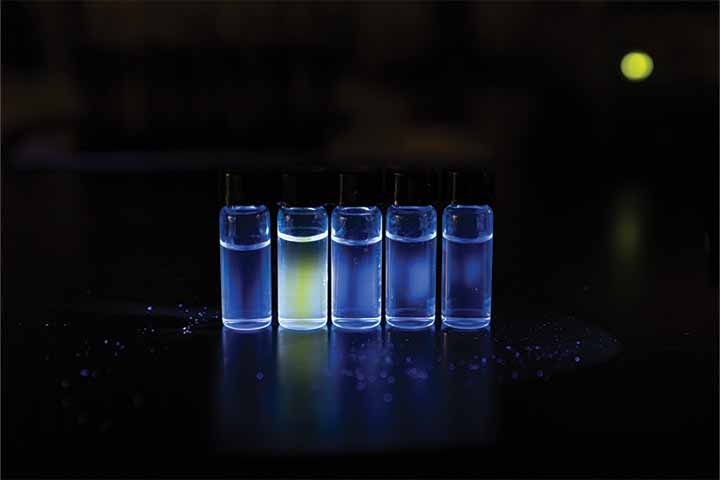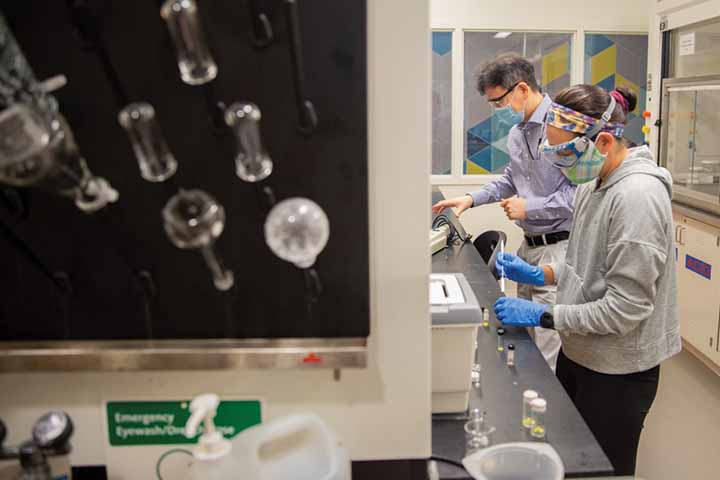Answers Glow in the Dark in Daniel Ki's Chemistry Lab
By Susan Allen '09, '14

By Susan Allen '09, '14

Andrew Wu ’23 arrived at a point in his college journey where he didn’t know what his major was going to be, and then he took Nanotechnology in our Society with Daniel Ki, associate professor of Chemistry.
One general studies class introduced him to science on an atomic scale, but more importantly, it gave him the clarity he was searching for in his own life and sparked his already curious mind.
Tiny molecules (on the scale of a billionth of a meter) can be engineered to solve big problems—like detecting chemicals in our water supply.
Wu decided right then and there, he was going to be a Biochemistry and Molecular Biology major.
“Some of the synthesis methods were mind boggling to me. I’m still so curious about chemical vapor deposition and atomic layer deposition. It sounds like something that should be science fiction. Atomic layering deposition is literally just layering atoms, but it’s not something you would think about intuitively. It’s a whole other world that people aren’t exposed to even though every day the technology we use is founded on these ideas and principles. To be behind the scenes learning how it works is something I find fulfilling,” he said.
Wu joined Ki’s research lab to work on a solution to detect high concentrations of fluoride in drinking water.
In some regions of the world, the water supply is not regulated. “While fluoride in small doses is actually beneficial to us, excessive doses can be detrimental to our health,” said Wu.

How can fluoride ions be detected? The solution they discovered is clearly visible, but only in the dark.
A chemical sensor is a device that can transform a chemical signal into a device signal to detect a chemical species. Ki and Wu developed a chemical sensor to detect fluoride ions.
Four test tubes containing blue-green solutions of bromide, iodide, chloride, and fluoride ions all looked identical on the lab counter until Ki shut off the lights and shined an ultraviolet light at the tubes.
The one test tube containing fluoride changed colors. A bright yellow glow signaled the presence of the fluoride ion that was not present in the three other tubes.
Their work was published in a high-impact, peer-reviewed journal, Dalton Transactions, by the Royal Society of Chemistry.
Ki’s lab is poised to explore an intriguing challenge: detecting per- and poly-fluoroalkyl substances (PFAS), also known as forever chemicals, because they can’t break down.
Mistakes can sometimes turn into miracles."Daniel Ki, associate professor of Chemistry
In April, the EPA issued the first-ever national drinking water standard to regulate exposure to toxic forever chemicals.
Wu was drawn to chemistry for the opportunity to create solutions to real-world problems. He will continue studying Chemistry as a Ph.D. student at the University of Delaware this fall, and he hopes to become a professor.
Wu believes that science works best when curiosity is embraced.
Ki added, “Mistakes can sometimes turn into miracles,” which is exactly what happened to his former student Kathleen Ngo, who is now a Ph.D. candidate at Northwestern University.
Ngo, a 2020 Chemistry and Biochemistry graduate, discovered a bright idea for a new type of light source after using an unexpected chemical during her research with Ki. They were creating tin chloride phosphors, a known compound that glows a dull yellow, until Ngo tried something slightly different - she used one different chemical by mistake - that resulted in a tin fluoride phosphor that glows brighter and green.
Ngo is studying how structure impacts the function of materials on a nanoscale in Northwestern’s Mirkin Lab.
Her work is focused on cancer vaccines that utilize the body’s own immune system to minimize the harsh side effects that accompany chemotherapy treatment.
She’s specifically looking at how the components of a vaccine are structured because certain structures of the same components can fight cancer more effectively.
She made an analogy using Legos. You can use the same pieces to build a house or a castle. The castle is going to be better at protecting intruders.
Like Wu, she, too, wants to become a professor. “To help shape future scientists would be so rewarding. I want teaching to be a part of my life,” she said.

Her Stockton experience pushed her to think critically like a scientist, and the classes showed her how chemistry works in the real world.
Her advice to students: “Keep an open mind. The classes are hard, but the payoff comes later,” she said.
“Professor Ki’s enthusiasm was the reason I joined his lab. He was interactive, had good energy, made me want to learn, motivated me and inspired me,” she said.